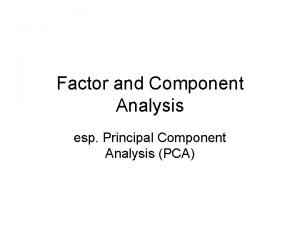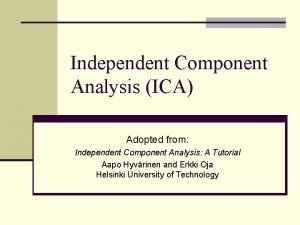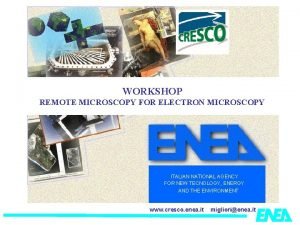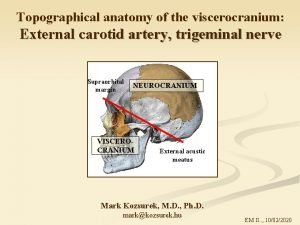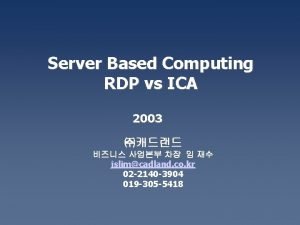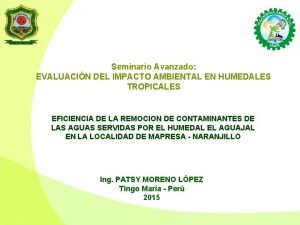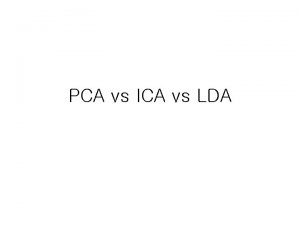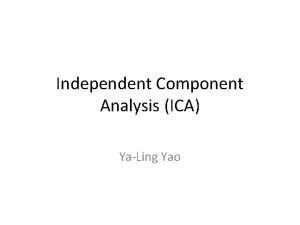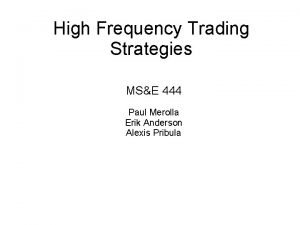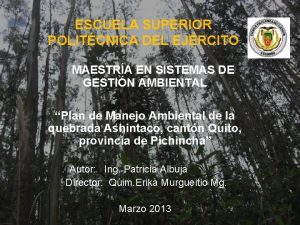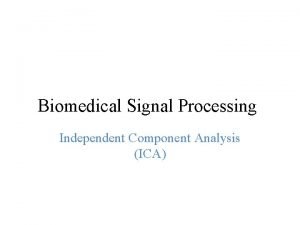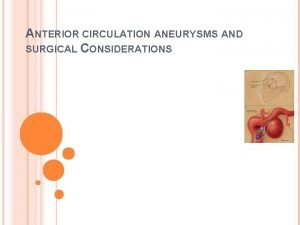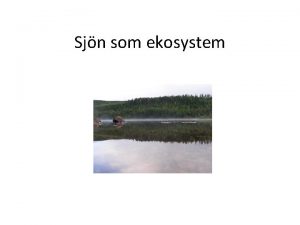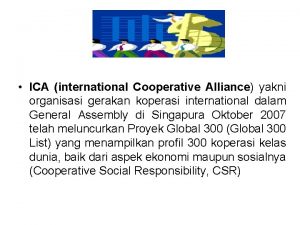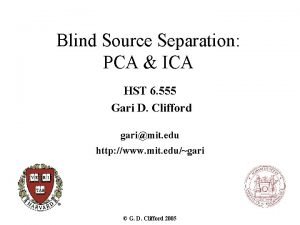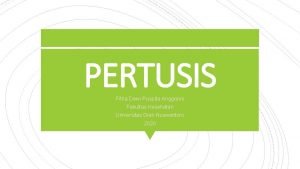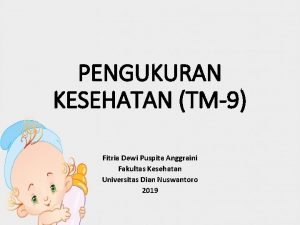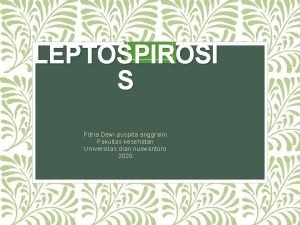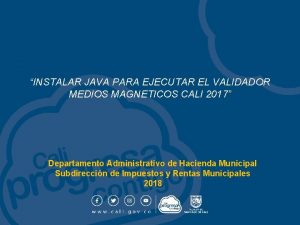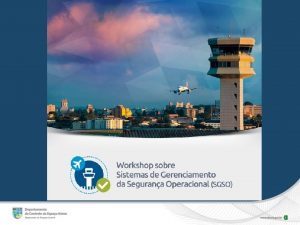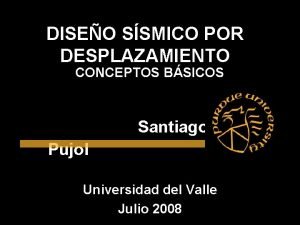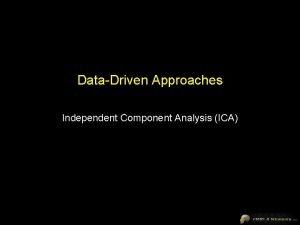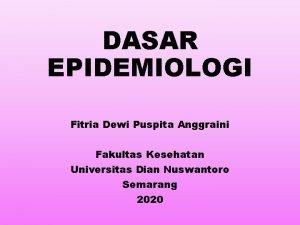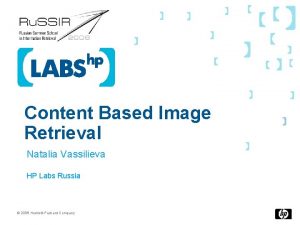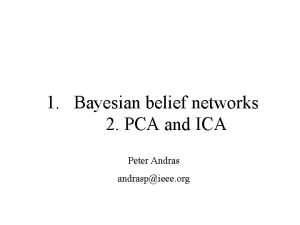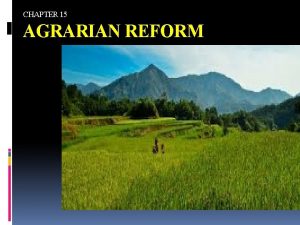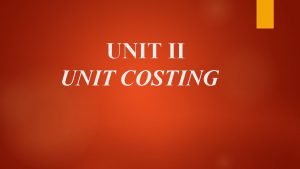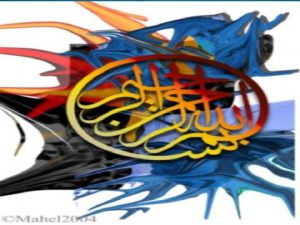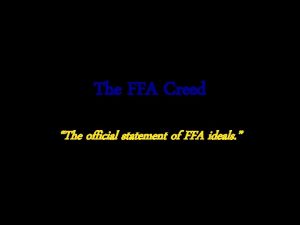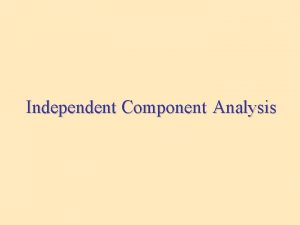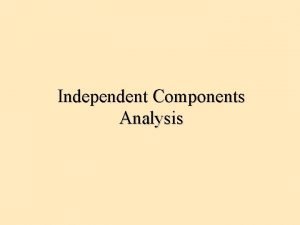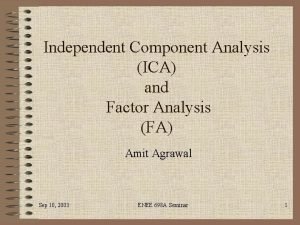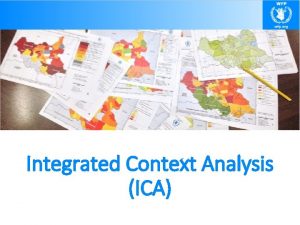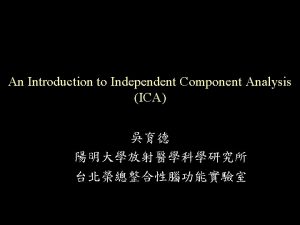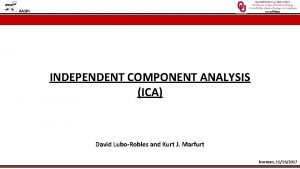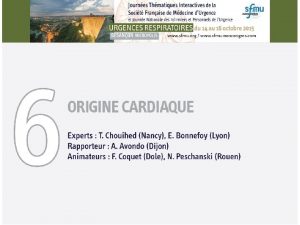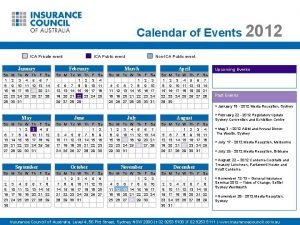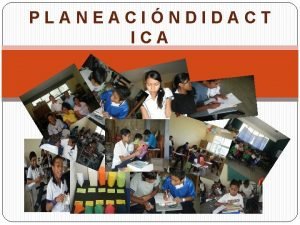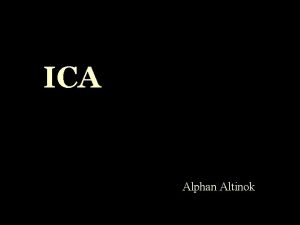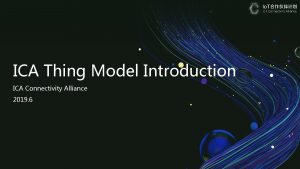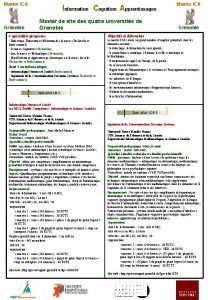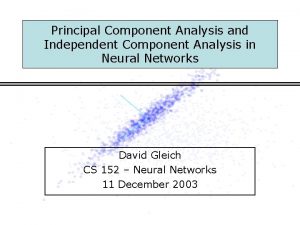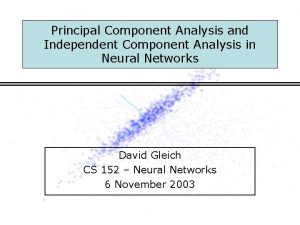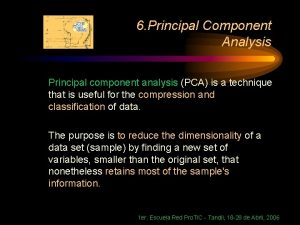Independent Component Analysis ICA Adopted from Independent Component





































- Slides: 37

Independent Component Analysis (ICA) Adopted from: Independent Component Analysis: A Tutorial Aapo Hyvärinen and Erkki Oja Helsinki University of Technology

Motivation n Example: Cocktail-Party-Problem

Motivation n 2 speakers, speaking simultaneously.

Motivation n 2 microphones in different locations

Motivation aij. . . depends on the distances of the microphones from the speakers

Problem Definition n Get the original signals out of the recorded ones.

Noise-free ICA model n Use statistical „latent variables“ system n Random variable sk instead of time signal n xj = aj 1 s 1 + aj 2 s 2 +. . + ajnsn, for all j x = As x = Sum(aisi) n ai. . . basis functions n si. . . independent components (IC‘s)

Generative Model n IC‘s s are latent variables => unknown n Mixing matrix A is also unknown n Task: estimate A and s using only the observeable random vector x

Restrictions n si are statistically independent n p(y 1, y 2) = p(y 1)p(y 2) n Non-gaussian distributions n Note: if only one IC is gaussian, the estimation is still possible

Solving the ICA model n Additional assumptions: n # of IC‘s = # of observable mixtures n => A is square and invertible n A is identifiable => estimate A n Compute W = A-1 n Obtain IC‘s from: s = Wx

Ambiguities (I) n Can‘t determine the variances (energies) of the IC‘s x = Sum[(1/Ci)aisi. Ci] n Fix magnitudes of IC‘s assuming unit variance: E{si 2} = 1 n Only ambiguity of sign remains n

Ambiguities (II) n Can‘t determine the order of the IC‘s n Terms can be freely interchanged, because both s and A are unknown n x = AP-1 Ps n P. . . permutation matrix

Centering the variables n Simplifying the algorithm: n Assume that both x and s have zero mean n Preprocessing: x = x‘ – E{x‘} n IC‘s are also zero mean because of: E{s} = A-1 E{x} n After ICA: add A-1 E{x‘} to zero mean IC‘s

Noisy ICA model x = As + n n A. . . mxn mixing matrix n s. . . n-dimensional vector of IC‘s n n. . . m-dimensional random noise vector n Same assumptions as for noise-free model

General ICA model n Find a linear transformation: n n s = Wx si as independent as possible Maximize F(s) : Measure of independence No assumptions on data Problem: n n definition for measure of independence Strict independence is in general impossible

Illustration (I) n 2 IC‘s with distribution: n zero mean and variance equal to 1 n Joint distribution of IC‘s:

Illustration (II) n Mixing matrix: n Joint distribution of observed mixtures:

Other Problems n Blind Source/Signal Separation (BSS) n Cocktail Party Problem (another definition) n Electroencephalogram n Radar n Mobile Communication n Feature extraction n Image, Audio, Video, . . . representation

Principles of ICA Estimation n “Nongaussian is independent”: central limit theorem n Measure of nonguassianity n Kurtosis: (Kurtosis=0 for a gaussian distribution) n Negentropy: a gaussian variable has the largest entropy among all random variables of equal variance:

Approximations of Negentropy (1)

Approximations of Negentropy (2)

The Fast. ICA Algorithm

4 Signal BSS demo (original)

4 Signal BSS demo (Mixtures)

4 Signal BSS demo (ICA)

Fast. ICA demo (mixtures)

Fast. ICA demo (whitened)

Fast. ICA demo (step 1)

Fast. ICA demo (step 2)

Fast. ICA demo (step 3)

Fast. ICA demo (step 4)

Fast. ICA demo (step 5 - end)

Other Algorithms for BSS n Temporal Predictability n TP of mixture < TP of any source signal n Maximize TP to seperate signals n Works also on signals with Gaussian PDF n Co. Bli. SS n Works in frequency domain n Only using the covariance matrix of the observation n JADE

Links 1 n Feature extraction (Images, Video) n http: //hlab. phys. rug. nl/demos/ica/ n Aapo Hyvarinen: ICA (1999) n http: //www. cis. hut. fi/aapo/papers/NCS 99 web/node 11. ht ml n ICA demo step-by-step n http: //www. cis. hut. fi/projects/icademo/ n Lots of links n http: //sound. media. mit. edu/~paris/ica. html

Links 2 n object-based audio capture demos n http: //www. media. mit. edu/~westner/sepdemo. html n Demo for BBS with „Co. Bli. SS“ (wav-files) n http: //www. esp. ele. tue. nl/onderzoek/daniels/BSS. html n Tomas Zeman‘s page on BSS research n http: //ica. fun-thom. misto. cz/page 3. html n Virtual Laboratories in Probability and Statistics n http: //www. math. uah. edu/stat/index. html

Links 3 n An efficient batch algorithm: JADE n http: //www-sig. enst. fr/~cardoso/guidesepsou. html n Dr JV Stone: ICA and Temporal Predictability n http: //www. shef. ac. uk/~pc 1 jvs/ n BBS with Degenerate Unmixing Estimation Technique (papers) n http: //www. princeton. edu/~srickard/bss. html

Links 4 n detailed information for scientists, engineers and industrials about ICA n http: //www. cnl. salk. edu/~tewon/ica_cnl. html n Fast. ICA package for matlab n http: //www. cis. hut. fi/projects/ica/fastica/fp. shtml n Aapo Hyvärinen n http: //www. cis. hut. fi/~aapo/ n Erkki Oja n http: //www. cis. hut. fi/~oja/
 Pca vs ica
Pca vs ica Independent component analysis tutorial
Independent component analysis tutorial Sism9
Sism9 Pear shaped pad mandible
Pear shaped pad mandible Ica vs rdp
Ica vs rdp Indice ica
Indice ica Pca lda
Pca lda Pca vs ica
Pca vs ica Ica hörnan enhörna
Ica hörnan enhörna Streaming xxnx
Streaming xxnx Ica capital
Ica capital Ica-nsf
Ica-nsf Pca vs ica
Pca vs ica Paraclinoid ica
Paraclinoid ica Djupbottenzonen
Djupbottenzonen ενδοθήλιο
ενδοθήλιο Organisasi ica
Organisasi ica Cocktail party problem ica
Cocktail party problem ica Ica puspita dewi anggraini
Ica puspita dewi anggraini Ica puspita dewi anggraini
Ica puspita dewi anggraini Ica puspita dewi anggraini
Ica puspita dewi anggraini Ica
Ica Validador medios ica cali
Validador medios ica cali Dca 63-3
Dca 63-3 Teff ica
Teff ica Ica
Ica Peristiwa bersejarah epidemiologi wabah diare di london
Peristiwa bersejarah epidemiologi wabah diare di london Ica vision
Ica vision Ica
Ica The method of unit costing is adopted by
The method of unit costing is adopted by Author of the ffa creed
Author of the ffa creed Compras y vandalas meaning
Compras y vandalas meaning The method of unit costing is adopted by
The method of unit costing is adopted by Public law 740 passed by congress
Public law 740 passed by congress Label the official dress for ffa
Label the official dress for ffa Mobile dispensing unit & drug basket are methods of
Mobile dispensing unit & drug basket are methods of Process adopted for curriculum development in pakistan
Process adopted for curriculum development in pakistan I believe in less dependence on begging
I believe in less dependence on begging
